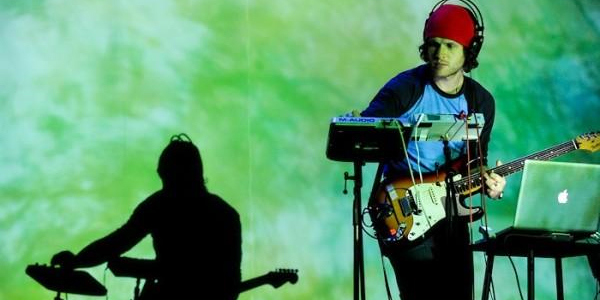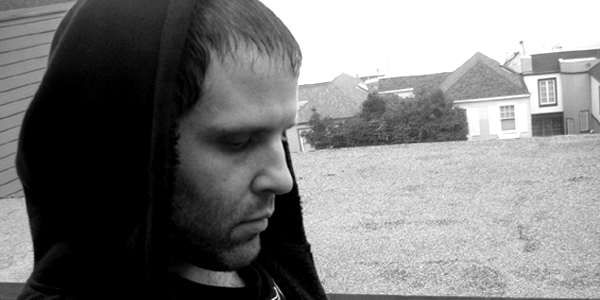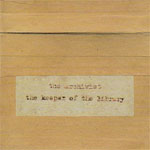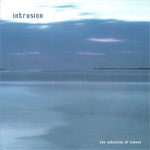
What does your name, "Phylum Sinter" mean?
Phylum Sinter is a name that i came up with after trying to define what the purpose of making music was for me. Making it was always a bit of a release, but i found the real objectives met -- even if they were never really defined -- after the music was heard by other people and whether it really moved them at all, like the songs were in some ways a log of recent internal processing that was spun into this audible tapestry easily validated by acknowledgment of rhythm or empathy somehow. Taking this into account, i also wanted a moniker that was generalized enough to be resistant to time. I was reading alot about taxonomy at the time, and just how science classifies different species. The decision to use 'Phylum' instead of 'Kingdom' or any of the other three rungs below it came about because i realized that this is where basic structures of biology begin to show commonalities of lifespan, even behavioral and bone structures and such begin to sit within ranks. In short, it is where purpose begins to emerge. 'Sinter' came to mind after searching for good words that meant to compress, to sigil-ize or basically make a compound of meanings and transmit it. To sinter something means to concentrate it, to distill it into its most base form. Together the name can be defined as a species that would make these things (in my case, songs) that hopefully have transmittable core elements. I'm very big into music as a language and means of communication.
Who are some of your influences?
Alot of romantic and baroque classical music, especially piano composers. Specifically Chopin, De Bussy and Lizst are probably ingrained in my hands down to muscle memory. I also have heard somewhere that Pachalbel's Canon in D is the core of all modern music, that might be a joke but in any case it's one of the first pieces i learned to play and alot of the basic chord structures i end up using are probably sitting somewhere in there. Then on the flip side i've got an incredible appreciation for chiptunes and videogame composers, alot of my first songs written inside a computer were done on tracker programs, so that aesthetic and limitation informed my approach to arrangement. Film scores are also a great influence to me, and an area i really want to get more involved in. Music is one of the greatest ways of transmitting a cross-sensory or synaesthetic idea, and i find it very visual, so creating visuals to match my sounds is a hobby of mine too -- often inspired from geometric surrealists like Peter Gric and H.R. Giger, M.C. Escher, the dreamtime portraits of Gil Bruvel and stuff that implies there is more here than can be easily recognized.
What is some of the hardware/software that you use to produce?
I use a bunch of cheap circuitbent crap, most of which was bent by friends or myself as sound sources. You don't hear much stuff going nuts on its' own in my tracks because it's all chopped and arranged in a pretty meticulous manner. Stochastic music isn't my thing, if i want that i can just throw some bricks in my dryer and let it clank around, you know? Big fan of Yamaha FM synths, have two TX-81Z's that are on just about every one of my songs somewhere. Also some other hardware, a Yamaha SK-30 which is one of those big wooden ended analogue synths, 4 voice; a Korg ms-2000r. Then we've got my main controller keyboard, a Yamaha CS1x, Behringer and Oxygen knob boxes. Tend to get alot of found sounds from my trusty minidisc recorder and stereo mini condenser mic. I'd like to make an album someday with absolutely no sequencing, so i'll probably keep my Roland VS-1680 (which hardly gets used for anything more than live-takes these days) around. On the software side i run alot of rube-goldberg style modulation mazes in Max/MSP where i have midi generated between just about every sound-source and fed-back into something else. Alot of my synth sounds come from Reaktor and freeware vst's (the Crystal and Synth1 are perfect for just about everything). Used to hunt for alot of effects and stuff, nowadays i tend to try to crossmodulate and layer the stuff i have in new ways.
There is a lot of harmony in your atmospherics and melodies. Do you play any instruments?
Yes, i play alot of instruments. Keyboards since age 6 or so, guitar since 12, clarinet since 14, drums since 16, dulcimer, marimba, kalimba, and just about anything else i get a handle on i tend to be able to play pretty well after awhile... save for stringed instruments, i can't seem to get a handle on bow technique. Would love to get some training on the cello, but it would be the first time i've ever gotten lessons and i have a feeling they wouldn't sit easy with me.
Tell us a bit about your upcoming album on Tympanik Audio.
The album is my prime focus, a bit of a cleansing ritual in and of itself. Over the past 5 years i've accumulated a whole lot of ideas, sketches, effects patches and atmospherics (field recordings, narration and such) that have somehow been growing without my knowledge. Tympanik approached me in 2007 i believe, and asked me for an album. At the time i was already at work on 'From Unity to Segmentation' and hadn't realized how much my health was going to slow me down (i was later diagnosed with Autoimmune Hemolytic Anemia and had to have my spleen removed in the summer of 07). So after 'Unity' was finished, i decided to take everything that has defined my current sound and give it a proper send-off with Tympanik -- it'll be called 'Amongst Fauna and Wiring' and i'm hoping to get it completed this year. Alot of what is going into the arrangement is a steampunk aesthetic, it won't be overt but there should be some sense that the overall product was not made in this time, or even this world; it's incorporating alot of pneumatic, clangerous and field recordings i've done walking around the once-great, now abandoned Detroit Train Station and thereabouts. There's also a good chance that i'll be bringing a few people in to do remixes -- hopefully those details will get solidified soon and i can announce a release date.
Simultaneously i'm finishing up another EP that i had discussed a few years ago with MMR [http://www.middlemanagement.net]. I'm really much closer to releasing this ep, it'll be titled 'Detroit Nocturnes' and is a focus on music i've made in the wee hours of the night, usually after wandering through the city and coming home with too much energy for my body to let me sleep. It's kind of a sonnet to the city i grew up in, with some subtle nods to my heroes here and some tracks that were started live and then finished in the studio. This EP will be 6 tracks long i'll be finishing that up by the end of August, and it will be released by October of this year.
That pretty much covers it -- i'm itchy to get back on the road too but there's still a lot of stuff to finish first.
myspace.com/phylumsinter | phylumsinter.matterwave.net

 Proem doesn’t waste any time in setting the scene on Till There’s No Breath. On opening track These Are Demands, it’s as if there is a massive space ship descending from the sky, metal screeching and thrusters on full blast as it lands right in front of you. There are echoes of distorted alien-sounding voices mixed into the grating wall of metallic noise. The atmosphere is filled with foreboding. And it doesn’t let up on A Skin That Crawls, with its huge thumping footsteps echoing off the walls of what could be an underground sewer or cavern. If these words sound over the top, I defy you to listen to this music without having your imagination run rampant. And the rather disturbing track titles -- A Skin That Burns, Faceeater, Deadplate, Dull Throbbing – will inevitably nudge you in a particular direction. This is a dark place and death hangs in the air. But it’s not the kind of malevolence that hits you over the head with a hammer. It’s a quiet menace. An ambient nightmare. Like when the fellowship in the Lord of the Rings entered the Mines of Moria, you know that evil lurks deep within. Or at least an amoral consciousness. The title track Till There’s No Breath evokes a sensation of paralysis. Like being unable to move and helpless to escape the unthinkable. The man behind these disquieting soundscapes and the
Proem doesn’t waste any time in setting the scene on Till There’s No Breath. On opening track These Are Demands, it’s as if there is a massive space ship descending from the sky, metal screeching and thrusters on full blast as it lands right in front of you. There are echoes of distorted alien-sounding voices mixed into the grating wall of metallic noise. The atmosphere is filled with foreboding. And it doesn’t let up on A Skin That Crawls, with its huge thumping footsteps echoing off the walls of what could be an underground sewer or cavern. If these words sound over the top, I defy you to listen to this music without having your imagination run rampant. And the rather disturbing track titles -- A Skin That Burns, Faceeater, Deadplate, Dull Throbbing – will inevitably nudge you in a particular direction. This is a dark place and death hangs in the air. But it’s not the kind of malevolence that hits you over the head with a hammer. It’s a quiet menace. An ambient nightmare. Like when the fellowship in the Lord of the Rings entered the Mines of Moria, you know that evil lurks deep within. Or at least an amoral consciousness. The title track Till There’s No Breath evokes a sensation of paralysis. Like being unable to move and helpless to escape the unthinkable. The man behind these disquieting soundscapes and the 
 Fans of Christopher Willits rejoice! The San Francisco based musician has something special just for you! If you were one of the lucky 1111 fans to first join the
Fans of Christopher Willits rejoice! The San Francisco based musician has something special just for you! If you were one of the lucky 1111 fans to first join the 
 On his first full-length album, White Clouds Drift On And On, Brock Van Wey (better known as Bvdub) abandons dub techno conventions and returns to his West Coast chill-out room roots. It’s a step in the right direction, making for some of his most emotional music to date. The opening track, “Too Little Too Late” is gentle and ambient with voices drifting in and out of the mix. “I Knew Happiness Once” features fuller vocal samples that sound Eastern in origin. “Forever a Stranger” is beautiful and relaxing, with slow washes of textured sound. Repetitive choral pulses guide “A Gentle Hand to Hold.” I’m reminded of Philip Glass’ soundtrack for Koyaanisqatsi (in a good way). “A Chance to Start Over” seems to ask a question. Its ascending three-note pattern is joined by plucked strings and echoey vocals. The title piece is awash in long drifting chords. All six pieces are airy and beat-less with little bass. They are perfect for summer’s late twilight. I’m sure lazy afternoon or late-night post-party listening sessions would work equally well. Van Wey and Stephen Hitchell both played live at a LWE loft party in Chicago over the winter. They must have kept in touch, because not only did Hitchell publish this album, he also contributed a full disc of interpretations. These versions will undoubtedly please dub techno fans. The “Intrusion Shape” of the title track gradually reveals itself with full, deep bass and lingering chord caresses. It turns the uplifting original on its head, adding elements that are dark yet sensuous. At over twenty-four minutes, it’s no lightweight. The Intrusion version of “A Chance to Start Over (Intrusion Shape III)” bears little resemblance to the original, but is pretty in its own right, with contemplative analogue synthesizers and wonderful surface noise that gives way to downtempo percussion. “A Gentle Hand to Hold” gently sways to congas like a pop song de-constructed. There is an entire world built into its subtle changes. “I Knew Happiness Once (Intrusion Shape V)” reminds me of The Orb, but for being serious (and more sparse). On “Too Little Too Late (Intrusion Shape VI)” metal shivers and beats tick while piano notes glisten. This double CD is an amazing two-and-a-half hours of quality electronic music. Listening to it straight through, I’m reminded of the good old days when synthesizers offered glimpses of an alien world, when bedroom producers created whole atmospheres in space and time. Sometimes you need to look back to move forward. It’s a revival.
On his first full-length album, White Clouds Drift On And On, Brock Van Wey (better known as Bvdub) abandons dub techno conventions and returns to his West Coast chill-out room roots. It’s a step in the right direction, making for some of his most emotional music to date. The opening track, “Too Little Too Late” is gentle and ambient with voices drifting in and out of the mix. “I Knew Happiness Once” features fuller vocal samples that sound Eastern in origin. “Forever a Stranger” is beautiful and relaxing, with slow washes of textured sound. Repetitive choral pulses guide “A Gentle Hand to Hold.” I’m reminded of Philip Glass’ soundtrack for Koyaanisqatsi (in a good way). “A Chance to Start Over” seems to ask a question. Its ascending three-note pattern is joined by plucked strings and echoey vocals. The title piece is awash in long drifting chords. All six pieces are airy and beat-less with little bass. They are perfect for summer’s late twilight. I’m sure lazy afternoon or late-night post-party listening sessions would work equally well. Van Wey and Stephen Hitchell both played live at a LWE loft party in Chicago over the winter. They must have kept in touch, because not only did Hitchell publish this album, he also contributed a full disc of interpretations. These versions will undoubtedly please dub techno fans. The “Intrusion Shape” of the title track gradually reveals itself with full, deep bass and lingering chord caresses. It turns the uplifting original on its head, adding elements that are dark yet sensuous. At over twenty-four minutes, it’s no lightweight. The Intrusion version of “A Chance to Start Over (Intrusion Shape III)” bears little resemblance to the original, but is pretty in its own right, with contemplative analogue synthesizers and wonderful surface noise that gives way to downtempo percussion. “A Gentle Hand to Hold” gently sways to congas like a pop song de-constructed. There is an entire world built into its subtle changes. “I Knew Happiness Once (Intrusion Shape V)” reminds me of The Orb, but for being serious (and more sparse). On “Too Little Too Late (Intrusion Shape VI)” metal shivers and beats tick while piano notes glisten. This double CD is an amazing two-and-a-half hours of quality electronic music. Listening to it straight through, I’m reminded of the good old days when synthesizers offered glimpses of an alien world, when bedroom producers created whole atmospheres in space and time. Sometimes you need to look back to move forward. It’s a revival.
 If it looks like I am desperately trying to catch up on some amazing albums, and tell you about them since they first came out, it's because I am. There is just way too much music for me to go through these days. And let's face it, complaining about too much good music is a sin. Yet the fact that I have already listed Eyes Like Brontide on my
If it looks like I am desperately trying to catch up on some amazing albums, and tell you about them since they first came out, it's because I am. There is just way too much music for me to go through these days. And let's face it, complaining about too much good music is a sin. Yet the fact that I have already listed Eyes Like Brontide on my 
 Out of a small label in the UK, run by fabulous Miss Alice and Andrew Hargreaves, comes a beautifully crafted release from The Archivist. This is only the second release for the label, but OK, it's got my attention! At first, I was a bit surprised at the intricate production behind the album, The Keeper Of The Library, but once I realized who was behind it, I had that sigh of relief that comes with familiarity of the sound. The Archivist is none other than Craig Tattersall, whose name should be already familiar if you have ever subscribed to his releases as a member of The Boats, The Sea, Famous Boyfriend and of course, The Remote Viewer. As the alias and the title hints, the recordings on the album are compiled from an extensive archive of Tattersall's unreleased material. Some pieces have been scraped from crackling hard drives and hissing cassette tapes, accumulating to over 45 minutes in length. The first lucky 150 collectors were able to secure an additional 3" CDr that came within the handmade package. And the music... well, it speaks for itself. Tattersall uses lo-fi processed scratches and airy filtered percussion which he turns into beats with sparse melodies. Simplicity and elegance are at the core of this recording bringing lightweight electronica back to the home listening experience. Relying on repetition, the tracks roll over in beat with my morning train, glitching on chords, micro programmed rhythms and gentle strums of guitars. Using a coarse brush, the sounds are blotted around the audio canvas with plenty of space in between, leaving just enough room for the mind to rest, and fill in the gaps. This destitute pattern creates music full of fragile memories, elaborate design, and delicate beauty. If you're a fan, make sure to grab Tattersall's release as The Humble Bee, A Miscellany For The Quiet Hours (Cotton Goods, 2009) made from cassette tape-loops, as well as his offshoots and collaborations appearing on the Moteer label. See for example his collaboration with Andrew Hargreaves, where the duo take on the aliases Kibbee Theodore and Bernd Hamblin, to deliver The Scientific Contrast (Moteer, 2007). I also recommend you pick up Lacies' third release by Danny Norbury, Light In August. This album is highly recommended if you enjoy Pole, Arovane, and Yasume.
Out of a small label in the UK, run by fabulous Miss Alice and Andrew Hargreaves, comes a beautifully crafted release from The Archivist. This is only the second release for the label, but OK, it's got my attention! At first, I was a bit surprised at the intricate production behind the album, The Keeper Of The Library, but once I realized who was behind it, I had that sigh of relief that comes with familiarity of the sound. The Archivist is none other than Craig Tattersall, whose name should be already familiar if you have ever subscribed to his releases as a member of The Boats, The Sea, Famous Boyfriend and of course, The Remote Viewer. As the alias and the title hints, the recordings on the album are compiled from an extensive archive of Tattersall's unreleased material. Some pieces have been scraped from crackling hard drives and hissing cassette tapes, accumulating to over 45 minutes in length. The first lucky 150 collectors were able to secure an additional 3" CDr that came within the handmade package. And the music... well, it speaks for itself. Tattersall uses lo-fi processed scratches and airy filtered percussion which he turns into beats with sparse melodies. Simplicity and elegance are at the core of this recording bringing lightweight electronica back to the home listening experience. Relying on repetition, the tracks roll over in beat with my morning train, glitching on chords, micro programmed rhythms and gentle strums of guitars. Using a coarse brush, the sounds are blotted around the audio canvas with plenty of space in between, leaving just enough room for the mind to rest, and fill in the gaps. This destitute pattern creates music full of fragile memories, elaborate design, and delicate beauty. If you're a fan, make sure to grab Tattersall's release as The Humble Bee, A Miscellany For The Quiet Hours (Cotton Goods, 2009) made from cassette tape-loops, as well as his offshoots and collaborations appearing on the Moteer label. See for example his collaboration with Andrew Hargreaves, where the duo take on the aliases Kibbee Theodore and Bernd Hamblin, to deliver The Scientific Contrast (Moteer, 2007). I also recommend you pick up Lacies' third release by Danny Norbury, Light In August. This album is highly recommended if you enjoy Pole, Arovane, and Yasume. When
When 
 The dub sound of Intrusion is like an early stroll along the empty beach. Waves of white noise and minor chords splash and bounce against the glistening, polished, and rolling bass. The rhythm is measured, natural and hypnotic. The background four-four beat creates a trance-like experience. And the overall emotion is indeed seductive. Although the formula behind the production builds up on the previous successful sound of Echospace, the warmer side of the duo perfects the minimalism by injecting a fusion of Jamaican and South African dub. And it works. I could listen to this album over and over, like a head cleaner, after dense days, heavy nights and exhausting people. The minimal dub techno sound of Intrusion no doubt belongs to none other than Stephen Hitchell, one half of the above mentioned Echospace, who along with Rod Modell froze our hearts with The Coldest Season (Modern Love, 2007). Where as the latter critically acclaimed album captured the lower spectrum of the virtual thermometer with swishes of wind and falling snow, The Seduction Of Silence is more than a few degrees warmer. This is indeed a lovely twilight stroll under the ocean. The album is the first full length solo release for Hitchell, inadvertently compiling previously released EPs and 12-inchers. This may, perhaps, be an answer to a solo release by Modell, Incense and Black Light (Plop, 2007), with Hitchell taking his turn to demonstrate his individuality. The album welcomes an appearance by Paul St. Hilaire (Tikiman), where the Dominican artist contributed reggae vocals. The tracks morph into one another with swells of white noise, sometimes clocking in at over 11 minutes long. Tswana Dub is perhaps one of my favorites, having previously appeared as a limited 12" on Intrusion's sub-label of Echospace. Recommended if you appreciate the sound of minimal dub from Modern Love and Basic Channel, as well as Yagya, Gas, and of course, DeepChord Presents Echospace. Last minute edit: be sure to pickup the latest release on Echospace [detroit] by Brock Van Wey (aka bvdub) titled White Clouds Drift On And On. This is a double disk release with the second part full of Hitchell's interpretations of Wey's original works. Truly sublime. Back to back!
The dub sound of Intrusion is like an early stroll along the empty beach. Waves of white noise and minor chords splash and bounce against the glistening, polished, and rolling bass. The rhythm is measured, natural and hypnotic. The background four-four beat creates a trance-like experience. And the overall emotion is indeed seductive. Although the formula behind the production builds up on the previous successful sound of Echospace, the warmer side of the duo perfects the minimalism by injecting a fusion of Jamaican and South African dub. And it works. I could listen to this album over and over, like a head cleaner, after dense days, heavy nights and exhausting people. The minimal dub techno sound of Intrusion no doubt belongs to none other than Stephen Hitchell, one half of the above mentioned Echospace, who along with Rod Modell froze our hearts with The Coldest Season (Modern Love, 2007). Where as the latter critically acclaimed album captured the lower spectrum of the virtual thermometer with swishes of wind and falling snow, The Seduction Of Silence is more than a few degrees warmer. This is indeed a lovely twilight stroll under the ocean. The album is the first full length solo release for Hitchell, inadvertently compiling previously released EPs and 12-inchers. This may, perhaps, be an answer to a solo release by Modell, Incense and Black Light (Plop, 2007), with Hitchell taking his turn to demonstrate his individuality. The album welcomes an appearance by Paul St. Hilaire (Tikiman), where the Dominican artist contributed reggae vocals. The tracks morph into one another with swells of white noise, sometimes clocking in at over 11 minutes long. Tswana Dub is perhaps one of my favorites, having previously appeared as a limited 12" on Intrusion's sub-label of Echospace. Recommended if you appreciate the sound of minimal dub from Modern Love and Basic Channel, as well as Yagya, Gas, and of course, DeepChord Presents Echospace. Last minute edit: be sure to pickup the latest release on Echospace [detroit] by Brock Van Wey (aka bvdub) titled White Clouds Drift On And On. This is a double disk release with the second part full of Hitchell's interpretations of Wey's original works. Truly sublime. Back to back!

 As I queue up the latest release from Planet Mu, the long awaited Variance by Jega, I realize that I never got the chance to tell you about one of my favorite albums of the year so far, Arecibo Message by none other than Barry Lynn. Meanwhile, I've spun these glitch influenced, dirty, acid, and deep dubstep beats over a dozen times. This Northern Ireland musician continues to impress me with his advanced production skills, unlimited bag of tricks, and intelligent tracks that retain their value throughout the years. I say that, because Oneiric (Planet Mu, 2006) and Glyphic (Planet Mu, 2007) still show up in my rotations on a regular basis. For his third full length album under Boxcutter, Lynn takes his production even further. Although still relying on dubstep structure, the elements of acid house, jazz, garage, and of course, IDM, are incorporated deeper into the music. Even vocals made it on to the album with a slightly poppy track, A Familiar Sound. The bass is always in the spotlight, sounding more analogue than before, living in its own frequency space around the painstakingly effected beats and individual elements prickling the neurons of your constantly wandering mind. The album title, Arecibo Message, refers to a message beamed into outer space via FM radio waves during a ceremony celebrating a remodeling of the radio telescope, located in Arecibo, Puerto Rico. This signal was transmitted only once. And I'm not sure what Lynn is referring to with this reference, but the same titled track has been already played over and over on these speakers. This is a must have for those a bit tired by the constant dubstep grind, and want to add a little spice into their daily muddled wobble. Good to know someone keeps the genre on the edge of experimental electronica. If you like your dubstep with a zing, then Boxcutter is for you! Besides the above mentioned albums there are more goodies from Lynn. Last year, he delivered a collection of previously unreleased material produced in his earlier years, Balancing Lakes (Planet Mu, 2008). Although the tracks had a few dated components (namely because they were written between 2002 and 2005), they still made an impact on me, and the album rose to the top of my favorites for 2008. So make sure to grab that if you can. Recommended for fans of Vex'd, iTAL tEK, 2562 and Autechre.
As I queue up the latest release from Planet Mu, the long awaited Variance by Jega, I realize that I never got the chance to tell you about one of my favorite albums of the year so far, Arecibo Message by none other than Barry Lynn. Meanwhile, I've spun these glitch influenced, dirty, acid, and deep dubstep beats over a dozen times. This Northern Ireland musician continues to impress me with his advanced production skills, unlimited bag of tricks, and intelligent tracks that retain their value throughout the years. I say that, because Oneiric (Planet Mu, 2006) and Glyphic (Planet Mu, 2007) still show up in my rotations on a regular basis. For his third full length album under Boxcutter, Lynn takes his production even further. Although still relying on dubstep structure, the elements of acid house, jazz, garage, and of course, IDM, are incorporated deeper into the music. Even vocals made it on to the album with a slightly poppy track, A Familiar Sound. The bass is always in the spotlight, sounding more analogue than before, living in its own frequency space around the painstakingly effected beats and individual elements prickling the neurons of your constantly wandering mind. The album title, Arecibo Message, refers to a message beamed into outer space via FM radio waves during a ceremony celebrating a remodeling of the radio telescope, located in Arecibo, Puerto Rico. This signal was transmitted only once. And I'm not sure what Lynn is referring to with this reference, but the same titled track has been already played over and over on these speakers. This is a must have for those a bit tired by the constant dubstep grind, and want to add a little spice into their daily muddled wobble. Good to know someone keeps the genre on the edge of experimental electronica. If you like your dubstep with a zing, then Boxcutter is for you! Besides the above mentioned albums there are more goodies from Lynn. Last year, he delivered a collection of previously unreleased material produced in his earlier years, Balancing Lakes (Planet Mu, 2008). Although the tracks had a few dated components (namely because they were written between 2002 and 2005), they still made an impact on me, and the album rose to the top of my favorites for 2008. So make sure to grab that if you can. Recommended for fans of Vex'd, iTAL tEK, 2562 and Autechre.
 Once again it is tough for me to write a proper review. At most I feel as if I'm paying homage to a passing soul from one realm to the other. As if I'm finally saying these words a little too late. As if the words can fill an empty space for an unfulfilled obligation of an unfulfilled life. But, of course, it is the opposite of that. With these words I am only spreading the love which is already abundant through the music of Celer. Music that is wordless. Free of time and space. And as Danielle Baquet-Long continues her journey from this plane towards the unknown of the other, and her husband Will Long remains with us to wrap up the unfinished, may these words speak the speechless as the music goes on. Dear Dani... Thank you for all the little gifts. Thank you for music that can not be wrapped or packaged. You will always be with us. May you rest in peace.
Once again it is tough for me to write a proper review. At most I feel as if I'm paying homage to a passing soul from one realm to the other. As if I'm finally saying these words a little too late. As if the words can fill an empty space for an unfulfilled obligation of an unfulfilled life. But, of course, it is the opposite of that. With these words I am only spreading the love which is already abundant through the music of Celer. Music that is wordless. Free of time and space. And as Danielle Baquet-Long continues her journey from this plane towards the unknown of the other, and her husband Will Long remains with us to wrap up the unfinished, may these words speak the speechless as the music goes on. Dear Dani... Thank you for all the little gifts. Thank you for music that can not be wrapped or packaged. You will always be with us. May you rest in peace. On Enaged Touches the husband and wife duo digitally stretch the loops of field recordings and analog samples of ambient strings and minimal distant pads. The creative use of delays blending into almost metallic reverb resonates the sound beyond its cycling waves. As the beatless drony chords morph into deep vibrations of bass, swelling in dynamics along with my emotions, the sound rolls over my head towards my chest and then slips through the cracks in between the walls. At times, there is silence which is followed by an onslaught of frequencies reminiscent of chemicals flooding your brain. Recordings of passing trains bridge the creatively named passages by Danielle that touch the tear glands, and jerk the nerves with titles such as "A Once And Meaningful Life". Or the lengthy leaps of imagination with a title like "Hanging Herself On The Lonely Fifth Column (Gramophones That Remind Us Of What Sounds Once Were)". Yes, the latter in the double quotes is a single titling of a section within the two tracks of the album. The first at twenty-six minutes, and the last at fourty-and-a-half. The album cover features photography by Danielle during her journey through India. Will and Dani started writing music for each other. Sharing their love first through letters, and then through little gifts of sound, they self released over twenty five recordings, some digital only, some beautifully crafted in hand painted packaging. In 2008, Celer collaborated with Mathieu Ruhlmann on Mesoscaphe that got picked up by the Japanese minimal experimental label, Spekk. 2009 saw the duo release work on Dragon's Eye, Smallfish, and Digitalis Limited. Engaged Touches got picked up by Home Normal, a label specializing in minimal and organic sound. Started in 2009, the label has already released recordings by Library Tapes, The Boats, and Christopher Hipgrave. On July 8th, 2009, Danielle Baquet-Long passed away from heart failure. At only 26 years of age, Danielle has released numerous works under her solo moniker, Chubby Wolf. She is known for her poetry and writing, and of course as one half of Celer. A few months ago, in March 2009, I got to meet and interview the duo at the Los Angeles
On Enaged Touches the husband and wife duo digitally stretch the loops of field recordings and analog samples of ambient strings and minimal distant pads. The creative use of delays blending into almost metallic reverb resonates the sound beyond its cycling waves. As the beatless drony chords morph into deep vibrations of bass, swelling in dynamics along with my emotions, the sound rolls over my head towards my chest and then slips through the cracks in between the walls. At times, there is silence which is followed by an onslaught of frequencies reminiscent of chemicals flooding your brain. Recordings of passing trains bridge the creatively named passages by Danielle that touch the tear glands, and jerk the nerves with titles such as "A Once And Meaningful Life". Or the lengthy leaps of imagination with a title like "Hanging Herself On The Lonely Fifth Column (Gramophones That Remind Us Of What Sounds Once Were)". Yes, the latter in the double quotes is a single titling of a section within the two tracks of the album. The first at twenty-six minutes, and the last at fourty-and-a-half. The album cover features photography by Danielle during her journey through India. Will and Dani started writing music for each other. Sharing their love first through letters, and then through little gifts of sound, they self released over twenty five recordings, some digital only, some beautifully crafted in hand painted packaging. In 2008, Celer collaborated with Mathieu Ruhlmann on Mesoscaphe that got picked up by the Japanese minimal experimental label, Spekk. 2009 saw the duo release work on Dragon's Eye, Smallfish, and Digitalis Limited. Engaged Touches got picked up by Home Normal, a label specializing in minimal and organic sound. Started in 2009, the label has already released recordings by Library Tapes, The Boats, and Christopher Hipgrave. On July 8th, 2009, Danielle Baquet-Long passed away from heart failure. At only 26 years of age, Danielle has released numerous works under her solo moniker, Chubby Wolf. She is known for her poetry and writing, and of course as one half of Celer. A few months ago, in March 2009, I got to meet and interview the duo at the Los Angeles 

